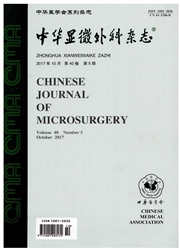

 中文摘要:
中文摘要:
目的 探讨不同的微应变环境对组织工程化周围神经移植体性能的影响. 方法 自2013年3月-2014年5月,将用低渗联合冻干技术改良法制成的兔脱细胞神经支架与PKH26标记的兔原代SCs复合,给予0%、5%、10%和15%形变量的微应变刺激后,修复兔坐骨神经缺损模型(缺损长度1 cm),另设自体神经移植组和正常对照组.8周时取出支架行苏木精-伊红(HE)及甲苯胺蓝染色,观察支架内细胞分布及髓鞘计数;S-100、GFAP及NF-200免疫荧光染色并测A值.病理切片后观察远端吻合口PKH26荧光示踪情况. 结果 改良法制成的支架内部髓鞘及SCs均被完全去除,细胞外基质成分保留完整.植入体内的支架8周时除15%形变量组结构崩解外,0%、5%、10%组支架内部基底层和神经纤维结构完整,呈波浪状分布.通过IPP软件计数髓鞘数目,发现10%形变量组高于0%、5%组,低于自体神经移植组,差异有统计学意义(P<0.05).10%形变量组S-100及GFAP免疫荧光染色A值(分别为2208.45±72.07和2666.93±102.49)明显高于0%、5%和自体神经移植组,低于空白对照组(2788.09±85.55和3609.65±107.41);NF-200免疫荧光染色A值10%形变量组(1947.57±61.24)高于0%(912.52±44.96)和5%组(1644.55±58.53),低于自体神经移植组(2329.35±86.81)和对照组(4545.66±103.12),差异均有统计学意义(P<0.05).0%、5%及10%形变量组8周时远端吻合口均可见PKH26红色荧光,15%组呈阴性. 结论 适度的(10%形变量)牵张应力微应变环境可以有效促进SCs的增殖及组织工程化周围神经的功能恢复。
 英文摘要:
英文摘要:
Objective To investigate the functional recovery of acellular nerve scaffolds with SCs after stimulated by different micro strain environments.Methods The PKH26-marked-SCs were seeded into the advanced scaffolds by the technique of freeze-drying and hypotonic buffer with the method of microinjection.The cell-scaffolds composites were stimulated by the different deformations (0%,5%,10% and 15%),and then were used to repair the rabbit sciatic nerve defect model(lcm-long).The histological characterizations of scaffolds were showed by the HE staining.Toluidine blue staining was used to reveal and count the myelinated nerve fibers,and S-100,GFAP and NF-200 of the scaffolds were examined with immunofluorescence at 8 weeks postoperatively.Results HE staining showed that the basal lamina and fibers of different deformations groups (0%,5%,10%) and autologous nerve group was arranged in a wave-like structure.The A of S-100 and GFAP in 10% deformation group (2208.45±72.07 and 2666.93±102.49,respectively) was higher compared with 0% and 5% deformation and autograft group,but less than the control group(2788.09±85.55 and 3609.65±107.41,respectively).The A of NF-200 in 10% deformation group was higher than 0% and 5% deformation group,but less than the autograft and control group.The red fluorescent of PKH26 was visible in the distal anastomosis of 0%,5% and 10% deformation groups,but was negative in 15% deformation group.Conclusion An appropriate micro tensile strain environment (10% deformation) may promote the proliferation of SCs and functional recovery of tissue-engineered peripheral nerve scaffold.
 同期刊论文项目
同期刊论文项目
 同项目期刊论文
同项目期刊论文
 Comparison of Decellularization Protocols for Preparing a Decellularized Porcine Annulus Fibrosus Sc
Comparison of Decellularization Protocols for Preparing a Decellularized Porcine Annulus Fibrosus Sc Novel cartilage-derived biomimetic scaffold for human nucleus pulpous regeneration: a promising ther
Novel cartilage-derived biomimetic scaffold for human nucleus pulpous regeneration: a promising ther 期刊信息
期刊信息
